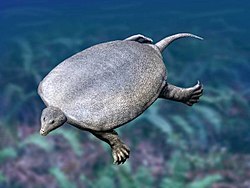| Guanling Formation | |
|---|---|
| Stratigraphic range: early-mid Anisian (Pelsonian) ~ | |
| Type | Geological formation |
| Underlies | Yangliujing Formation |
| Overlies | Jialingjiang Formation |
| Lithology | |
| Primary | Mudstone, limestone |
| Other | Dolomite |
| Location | |
| Coordinates | 25°30′N104°54′E / 25.5°N 104.9°E |
| Approximate paleocoordinates | 11°42′N94°12′E / 11.7°N 94.2°E |
| Region | Guizhou & Yunnan Provinces |
| Country | China |
| Extent | Yunnan–Guizhou Plateau |
The Guanling Formation is a Middle Triassic (Anisian or Pelsonian in the regional chronostratigraphy) geologic formation in southwestern China.

















